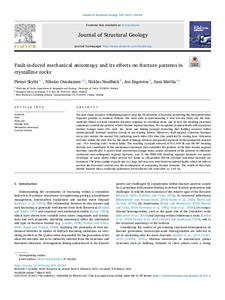Fault-induced mechanical anisotropy and its effects on fracture patterns in crystalline rocks
Ovaskainen Nikolas; Skyttä Pietari; Engström Jon; Mattila Jussi; Nordbäck Nicklas
https://urn.fi/URN:NBN:fi-fe2021093048506
Tiivistelmä
We used drone-acquired orthophotographs to map the 2D-networks of fractures transecting the Mesoproterozoic Rapakivi granites in southern Finland. The work aims at understanding i) how discrete faults and the kine-matically linked syn-fault extension fractures originate in crystalline rocks, and ii) how the resulting structural anisotropy controls the patterns of later-formed regional fractures. We recognized incipient faults with associated distinct damage zones (DZ; wall-, tip-, bend- and linking damage) indicating that faulting occurred within mesoscopically isotropic material devoid of pre-existing fabrics. Moreover, fault-induced extension fractures occur also outside the normal DZs indicating much wider DZs than that predicted by scaling laws. Extension fractures within the wide DZs are the result of linkage between sub-parallel segments of the dominantly sinistral and ~N-S trending (sub-) vertical faults. The resulting syn-fault network of N-S, NW-SE and NE-SW trending fracture sets contributed to the mechanical anisotropy that controlled the patterns of the later-formed regional fractures. Specifically, i) narrow fault reactivation damage zones caused deviations in the patterns of otherwise systematic near-orthogonal regional fractures, and ii) the NNW-SSE trending regional fractures are poorly developed in areas where either several N-S faults or sub-parallel NW-SE syn-fault extension fractures are dominant. The latter applies in particular to a large left step-over zone between sinistral faults, which we infer to provide the first-order control over the development of contrasting fracture domains. The results of this study further indicate that a strike-slip paleostress event affected the crust after ca. 1.65 Ga.
Kokoelmat
- Rinnakkaistallenteet [19207]
